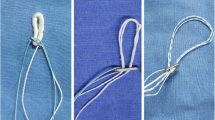Abstract
Purpose
The purpose was to conduct an independent biomechanical study comparing the main types of femoral fixation adapted to short hamstring grafts in anterior cruciate ligament (ACL) reconstruction surgery and to validate their performance.
Methods
The ACLip® Femoral, ToggleLoc™ Ziploop (TLZ), and Tape Locking Screw (TLS®) implants were tested in tension in the following three different configurations: implant alone, implant fixed on the femur without graft, and implant fixed on the femur with graft. Grafts alone were also tested. The femurs and the 4-strand semi-tendinosus grafts were derived from porcine and human models, respectively. Each set-up was subjected to the same protocol of creep (50 N for 30 s), cycling (1000 cycles between 50 and 250 N, 1 Hz), and load to failure (50 mm/min).
Results
A total of 93 tests were performed (30 ACLip®, 30 TLZ, 20 TLS®, and 13 ST4 alone). For the implants tested with femur and graft, the mean ± standard deviation (SD) overall elongation at 250 N after cycling was 5.2 ± 0.2 mm, 8.4 ± 2.1 mm, and 5.3 ± 0.8 mm, the mean ± SD ultimate load to failure was 736 ± 116 N, 830 ± 204 N, and 640 ± 242 N, and the mean ± SD stiffness at the 1000th cycle was 185 ± 15 N/mm, 172 ± 19 N/mm, and 178 ± 21 N/mm for ACLip®, ToggleLoc™, and TLS® devices, respectively. There was no significant difference between the implants except for post-cycling elongation between TLZ and the other two implants (p < 0.05).
Conclusion
The choice of femoral fixation device plays a decisive role in controlling the overall lengthening of an ACL reconstruction using a short hamstring graft. All implants validated the specifications in terms of ultimate load to failure, the TLS® system had, however, a low performance limit. ToggleLoc™ with adjustable loop should no longer be used on the femur side; instead the other types of fixation should be used to improve the overall elongation control.






Similar content being viewed by others
References
Ahmad SS, Hirschmann MT, Voumard B, Kohl S, Zysset P, Mukabeta T, Evangelopoulos DS, Ateschrang A (2018) Adjustable loop ACL suspension devices demonstrate less reliability in terms of reproducibility and irreversible displacement. Knee Surg Sports Traumatol Arthrosc 26:1392–1398
Ayzenberg M, Arango D, Gershkovich GE, Samuel PS, Saing M (2017) Pullout strength of a novel hybrid fixation technique (Tape Locking ScrewTM) in soft-tissue ACL reconstruction: a biomechanical study in human and porcine bone. Orthop Traumatol Surg Res OTSR 103:591–595
Barrow AE, Pilia M, Guda T, Kadrmas WR, Burns TC (2014) Femoral suspension devices for anterior cruciate ligament reconstruction: do adjustable loops lengthen? Am J Sports Med 42:343–349
Bonney H, Colston BJ, Goodman AM (2011) Regional variation in the mechanical properties of cortical bone from the porcine femur. Med Eng Phys 33:513–520
Brand J, Weiler A, Caborn DN, Brown CH, Johnson DL (2000) Graft fixation in cruciate ligament reconstruction. Am J Sports Med 28:761–774
Chang MJ, Bae TS, Moon Y-W, Ahn JH, Wang JH (2018) A comparative biomechanical study of femoral cortical suspension devices for soft-tissue anterior cruciate ligament reconstruction: adjustable-length loop versus fixed-length loop. Arthroscopy 34:566–572
Collette M (2012) An innovative method of hamstring graft preparation and a new concept of intratunnel tendon fixation: biomechanical evaluation. Curr Orthop Pract 23:577–583
Daniel DM, Stone ML, Sachs R, Malcom L (1985) Instrumented measurement of anterior knee laxity in patients with acute anterior cruciate ligament disruption. Am J Sports Med 13:401–407
Eguchi A, Ochi M, Adachi N, Deie M, Nakamae A, Usman MA (2014) Mechanical properties of suspensory fixation devices for anterior cruciate ligament reconstruction: comparison of the fixed-length loop device versus the adjustable-length loop device. Knee 21:743–748
Fu FH, Bennett CH, Lattermann C, Ma CB (1999) Current trends in anterior cruciate ligament reconstruction. Part 1: biology and biomechanics of reconstruction. Am J Sports Med 27:821–830
Hamner DL, Brown CH, Steiner ME, Hecker AT, Hayes WC (1999) Hamstring tendon grafts for reconstruction of the anterior cruciate ligament: biomechanical evaluation of the use of multiple strands and tensioning techniques. J Bone Joint Surg Am 81:549–557
Höher J, Livesay GA, Ma CB, Withrow JD, Fu FH, Woo SL (1999) Hamstring graft motion in the femoral bone tunnel when using titanium button/polyester tape fixation. Knee Surg Sports Traumatol Arthrosc 7:215–219
Houck DA, Kraeutler MJ, McCarty EC, Bravman JT (2018) Fixed- versus adjustable-loop femoral cortical suspension devices for anterior cruciate ligament reconstruction: a systematic review and meta-analysis of biomechanical studies. Orthop J Sports Med 6:2325967118801762
Jin C, Paluvadi SV, Lee S, Yoo S, Song E-K, Seon J-K (2018) Biomechanical comparisons of current suspensory fixation devices for anterior cruciate ligament reconstruction. Int Orthop 42:1291–1296
Johnson JS, Smith SD, LaPrade CM, Turnbull TL, LaPrade RF, Wijdicks CA (2015) A biomechanical comparison of femoral cortical suspension devices for soft tissue anterior cruciate ligament reconstruction under high loads. Am J Sports Med 43:154–160
Kirkpatrick SJ, Brooks BW (1998) Micromechanical behavior of cortical bone as inferred from laser speckle data. J Biomed Mater Res 39:373–379
Lee C-H, Huang G-S, Chao K-H, Wu S-S, Chen Q (2005) Differential pretensions of a flexor tendon graft for anterior cruciate ligament reconstruction: a biomechanical comparison in a porcine knee model. Arthroscopy 21:540–546
Morrison JB (1969) Function of the knee joint in various activities. Biomed Eng 4:573–580
Morrison JB (1968) Bioengineering analysis of force actions transmitted by the knee joint. J Biomed Eng 3:164
Noyes FR, Butler DL, Grood ES, Zernicke RF, Hefzy MS (1984) Biomechanical analysis of human ligament grafts used in knee-ligament repairs and reconstructions. J Bone Joint Surg Am 66:344–352
Nye DD, Mitchell WR, Liu W, Ostrander RV (2017) Biomechanical comparison of fixed-loop and adjustable-loop cortical suspensory devices for metaphyseal femoral-sided soft tissue graft fixation in anatomic anterior cruciate ligament reconstruction using a porcine model. Arthroscopy 33:1225-1232.e1
Papageorgiou CD, Ma CB, Abramowitch SD, Clineff TD, Woo SL (2001) A multidisciplinary study of the healing of an intraarticular anterior cruciate ligament graft in a goat model. Am J Sports Med 29:620–626
Pasquali M, Plante MJ, Monchik KO, Spenciner DB (2017) A comparison of three adjustable cortical button ACL fixation devices. Knee Surg Sports Traumatol Arthrosc 25:1613–1616
Petre BM, Smith SD, Jansson KS, de Meijer P-P, Hackett TR, LaPrade RF, Wijdicks CA (2013) Femoral cortical suspension devices for soft tissue anterior cruciate ligament reconstruction: a comparative biomechanical study. Am J Sports Med 41:416–422
Potel J-F, Franceschi J-P, Javois C, Jones D, Mouton C, Sbihi A, Seil R (2016) Valeur mécanique d’une fixation fémorale suspendue en os spongieux de tendons ischio-jambiers : étude des propriétés mécaniques de la fixation AClip® 12 modèles porcins et 12 mousses rigides de polyuréthane. Rev Chir Orthopédique Traumatol 102:S277
Prado M, Martín-Castilla B, Espejo-Reina A, Serrano-Fernández JM, Pérez-Blanca A, Ezquerro F (2013) Close-looped graft suturing improves mechanical properties of interference screw fixation in ACL reconstruction. Knee Surg Sports Traumatol Arthrosc 21:476–484
Robert H, Bowen M, Odry G, Collette M, Cassard X, Lanternier H, De Polignac T (2015) A comparison of four tibial-fixation systems in hamstring-graft anterior ligament reconstruction. Eur J Orthop Surg Traumatol Orthop Traumatol 25:339–347
Roos PJ, Hull ML, Howell SM (2004) Lengthening of double-looped tendon graft constructs in three regions after cyclic loading: a study using Roentgen stereophotogrammetric analysis. J Orthop Res 22:839–846
Rosenberg T, Brown G, Deffner K (1997) Anterior cruciate ligament reconstruction with a quadrupled semitendinosus autograft. Sports Med Arthrosc Rev 5:51
Simonian PT, Erickson MS, Larson RV, O’kane JW, (2000) Tunnel expansion after hamstring anterior cruciate ligament reconstruction with 1-incision EndoButton femoral fixation. Arthroscopy 16:707–714
Walton M (1999) Absorbable and metal interference screws: comparison of graft security during healing. Arthroscopy 15:818–826
Wascher DC, Markolf KL, Shapiro MS, Finerman GA (1993) Direct in vitro measurement of forces in the cruciate ligaments. Part I: the effect of multiplane loading in the intact knee. J Bone Joint Surg Am 75:377–386
Woo SL, Hollis JM, Adams DJ, Lyon RM, Takai S (1991) Tensile properties of the human femur-anterior cruciate ligament-tibia complex. The effects of specimen age and orientation. Am J Sports Med 19:217–225
Woo SL-Y, Karaoğlu S, Dede O (2006) Contribution of biomechanics to anterior cruciate ligament reconstruction. Acta Orthop Traumatol Turc 40:94–100
Acknowledgements
Bruyère-Garnier Karine, Université Gustave Eiffel, Laboratoire de Biomécanique et Mécanique des Chocs, Bron, France, for technical support. Ardizzone Stéphane, Université Gustave Eiffel, Laboratoire de Biomécanique et Mécanique des Chocs, Bron, France, for technical support. Benboubaker Leila, Université Gustave Eiffel, Laboratoire de Biomécanique et Mécanique des Chocs, Bron, France, for technical support. Boyer Hélène, Direction de la Recherche en Santé, Hospices Civils de Lyon, France, for manuscript preparation. Nierde Vanessa, Laboratoire d’anatomie, Université Claude Bernard Lyon 1, Lyon, France, for technical support. Subtil Fabien, Service de Biostatistiques des Hospices Civils de Lyon—Pôle de Santé Publique, Equipe Biostatistique Santé—LBBE—Université Claude Bernard Lyon 1, for statistical analysis support.
Funding
None.
Author information
Authors and Affiliations
Contributions
PR reviewed the literature, wrote the research protocol, conducted biomechanical tests, and wrote the manuscript. KE reviewed the literature, wrote the research protocol, conducted biomechanical tests, and proofread the manuscript. RF and BA supervised the research protocol, ensured technical assistance, and proofread the manuscript. GLL supervised the research protocol, conducted biomechanical tests, and proofread the manuscript.
Corresponding author
Ethics declarations
Conflict of interest
None.
Ethical approval
Not necessary.
Informed consent
Not necessary.
Additional information
Publisher's Note
Springer Nature remains neutral with regard to jurisdictional claims in published maps and institutional affiliations.
Supplementary Information
Below is the link to the electronic supplementary material.
Rights and permissions
About this article
Cite this article
Pacull, R., Kalk, E., Rongieras, F. et al. Anterior cruciate ligament reconstruction with short hamstring grafts: the choice of femoral fixation device matters in controlling overall lengthening. Knee Surg Sports Traumatol Arthrosc 30, 2215–2226 (2022). https://doi.org/10.1007/s00167-021-06783-6
Received:
Accepted:
Published:
Issue Date:
DOI: https://doi.org/10.1007/s00167-021-06783-6




